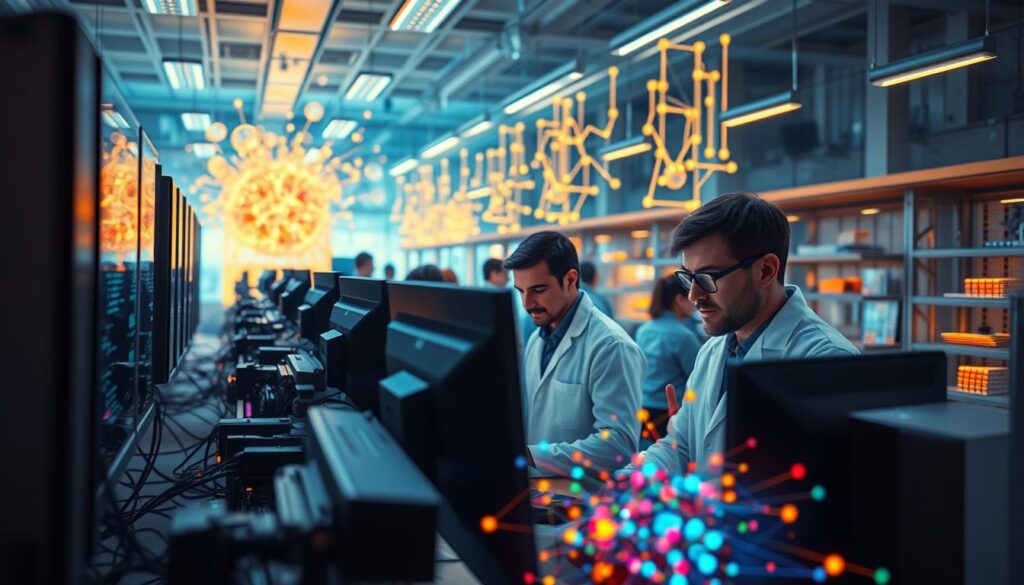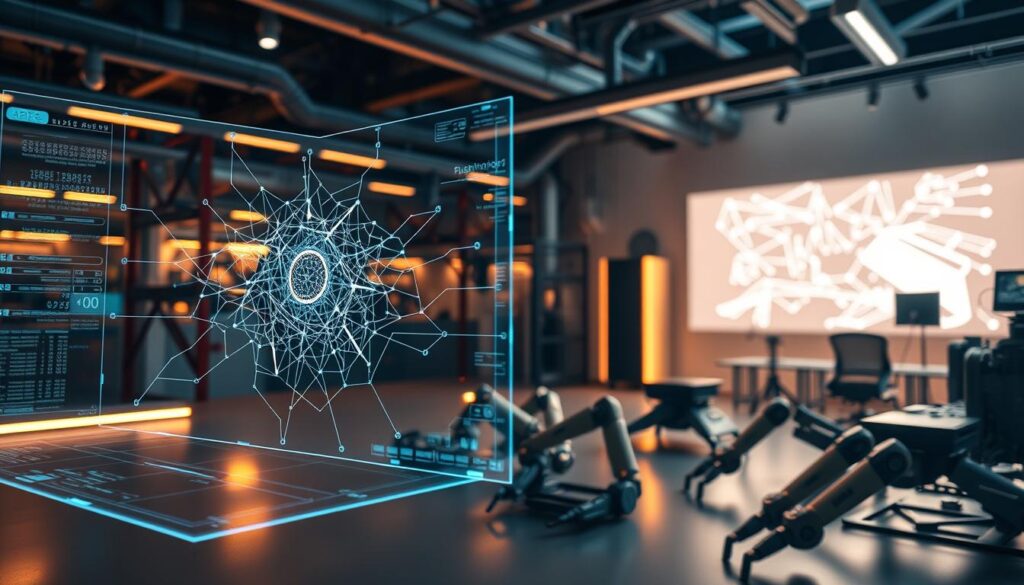Imagine machines that can understand and learn like us. This idea is at the core of cognitive computing. It's a new way of using Artificial Intelligence (AI) to make machines think like humans.
By using advanced tech, like Reinforcement Learning, cognitive computing is changing how we make decisions. It uses data to find new insights and improve how things work. This helps machines and humans work better together.
Key Takeaways
- Cognitive Computing integrates AI technologies to replicate human thought.
- Reinforcement Learning is crucial for enhancing AI's learning capabilities.
- Data-driven insights improve decision-making processes.
- Advancements in neural networks propel cognitive computing forward.
- This technology spans various industries, generating new opportunities.
Understanding Cognitive Computing
Cognitive Computing is a big step in technology. It makes machines think like us. This field helps machines understand data better. It makes them work like us, adapting to new things.
Learning about Cognitive Computing Definition shows how it changes things. It makes a big difference in many areas.
Definition and Importance
The Cognitive Computing Definition means systems that think like us. They help make better choices and solve problems. This is very important as more things rely on data.
Cognitive computing mixes machine power with human skills. It makes data work better, predict things, and understand language. Companies using it can offer unique solutions and insights.
The Role of AI in Cognitive Computing
AI is key in Cognitive Computing. It makes systems smarter and more automatic. AI helps machines understand language, find patterns, and make smart choices.
AI and cognitive computing together change technology. They make solutions more smart and efficient. This is a new way of doing things.
The Foundations of Artificial Intelligence
The journey of AI is amazing. It started with simple rules in the early 1900s. Now, we have deep learning that changes our world. AI combines math, computer science, and brain studies.
Historical Context of AI Development
AI began with early computers that could do simple things. Then, machine learning came in the 1950s. It helped create today's AI.
Alan Turing and John McCarthy were key. They helped AI grow. This led to neural networks and deep learning.
Key Components of AI Technologies
AI has many important parts. These are:
- Machine Learning: Systems that get better with data.
- Natural Language Processing: Computers that understand and speak human language.
- Computer Vision: Machines that see and make choices.
- Robotics: AI that does physical tasks on its own.
These parts help make cool things like self-driving cars and smart helpers. They also make recommendations just for you.
Reinforcement Learning: A Game Changer in AI
Reinforcement Learning (RL) is a big deal in artificial intelligence. It lets agents learn by trying things and getting feedback. This way, machines can make better choices and adapt in new ways.
Knowing the basics of Reinforcement Learning is key. It helps us see how it changes AI today.
Basics of Reinforcement Learning
At its core, Reinforcement Learning is about making smart choices. Agents learn from the environment, not just from data. They use rewards to know if they did well.
RL is all about trying new things and using what works. This keeps getting better over time.
Applications in Cognitive Computing
Reinforcement Learning has many uses, especially in cognitive computing. It helps train robots and make customer service better. Companies use it for new ideas, like managing resources well and making quick decisions.
| Application Area | Description | Impact |
|---|---|---|
| Robotics | Training robots to perform tasks effectively | Increased efficiency and adaptability in real-world scenarios |
| Marketing | Enhancing customer interactions through personalized strategies | Improved customer satisfaction and loyalty |
| Resource Management | Optimizing allocation of resources in real-time | Maximized operational efficiency and cost savings |
Exploring Machine Learning Techniques
Machine learning is key to artificial intelligence. It breaks down into types for different uses. Knowing these types helps use AI well. This part talks about the main types and the big difference between machine learning and deep learning.
Types of Machine Learning
There are three main types of machine learning:
- Supervised Learning: Uses labeled data to train algorithms. They then predict or classify new data.
- Unsupervised Learning: Looks at data without labels. It finds hidden patterns or groups, great for exploring data.
- Reinforcement Learning: Teaches agents to act in an environment to get rewards. It's used in games and robotics.
Machine Learning vs. Deep Learning
Machine learning and deep learning both help machines learn from data. But they are different in how they approach it. Deep learning uses neural networks with many layers.
| Aspect | Machine Learning | Deep Learning |
|---|---|---|
| Data Requirement | Smaller datasets are viable | Requires large amounts of data for effective training |
| Feature Engineering | Relies on manual feature extraction | Automatically detects features through neural networks |
| Computation Power | Less demanding | More demanding, often requiring specialized hardware like GPUs |
Choosing between machine learning and deep learning depends on the problem, data, and goals. Knowing the differences helps make better AI choices.

Understanding Deep Reinforcement Learning
Deep Reinforcement Learning (DRL) is a big step in artificial intelligence. It combines old learning methods with new deep learning. This lets agents learn and make choices in tough places.
This is different from old ways of learning. Old methods can't handle lots of data well. But DRL can.
How It Differs from Traditional Reinforcement Learning
DRL uses deep neural networks to understand data. This is unlike old methods that use simple models. Old methods can't handle big data well.
DRL can solve complex problems. It lets agents learn in ways they couldn't before.
Advanced Applications in Autonomous Systems
DRL is used in many fields, like self-driving cars. These cars learn to drive in changing situations. They use data from sensors to make quick decisions.
DRL is also used in robots, healthcare, and finance. It shows how useful it can be in many areas.
The Role of Reward Function in Learning
The reward function is key in reinforcement learning. It helps agents learn by guiding them. A good reward function makes learning faster and better.
Importance of Reward in the Learning Process
Rewards are very important in learning. They tell agents what happens because of their actions. A good reward system helps agents learn the right things.
When agents get rewards quickly, they learn faster. This makes learning easier for them.
Common Strategies for Implementing Reward Functions
There are many ways to use reward functions. Here are a few:
- Sparse Rewards: Rewards are given rarely. This makes agents think harder but learn more.
- Dense Rewards: Rewards are given often. This helps agents learn faster with more feedback.
- Shaping Rewards: Breaks tasks into smaller steps. This helps agents learn the right way step by step.
Choosing the right way to use rewards is important. It helps agents reach their goals better. Knowing these methods makes learning more effective.
Q-Learning and Its Impact on Cognitive Computing
Q-Learning is a key part of learning by doing. It lets agents try different actions to see what works best. This Q-Learning Overview shows how it helps make better choices over time. It's very important for improving how computers think.
Overview of Q-Learning
This method uses a Q-table to figure out the best actions. Agents learn by trying things and seeing what happens. This helps them pick the best actions for rewards. Q-Learning is used in many areas, like AI, robotics, and economics.
Real-World Use Cases
Many industries use Q-Learning to make things better. For example:
- Robotics: Training robots to move around easily.
- Gaming: Creating AI that changes its plan while playing.
- Logistics: Finding the best way to deliver things.
The table below shows some examples of Q-Learning Use Cases:
| Industry | Application | Benefits |
|---|---|---|
| Robotics | Autonomous navigation | Improved operational efficiency and adaptability |
| Gaming | Dynamic enemy AI | Enhanced user engagement and immersion |
| Logistics | Route optimization | Cost reduction and improved delivery times |
Policy Gradient Methods Explained
Policy Gradient Methods are a special way to learn in reinforcement learning. They focus on improving the policy, which is how the agent acts. This is different from old ways that looked at action values.
They are great when there are lots of actions or actions that can change a lot. This helps the agent make better choices.
Understanding Policy Gradients
Agents learn the best actions with Policy Gradient Methods. They look at the chances of each action. This helps them do well in hard tasks like understanding language and making smart plans.
Comparison with Value-Based Methods
Policy Gradients and Value-Based Methods are different. Value-Based Methods have trouble with many actions. Policy Gradients do better in complex situations.
This makes Policy Gradients better for solving many kinds of problems.
| Aspect | Policy Gradient Methods | Value-Based Methods |
|---|---|---|
| Action Space | Handles large or continuous spaces effectively | Typically limited to discrete actions |
| Learning Approach | Directly optimizes policy | Estimates value of actions |
| Performance in Complexity | Generally performs better in complex environments | Can struggle with intricate scenarios |
| Applications | Useful in language processing, decision making | Common in simpler problem domains |
Navigating the Markov Decision Process
The Markov Decision Process (MDP) is key for solving problems that change over time. It uses states, actions, rewards, and how things change to help solve big problems. This model is important for making smart choices in computers.
Introduction to MDPs
MDPs in AI help make smart choices by looking at many options. They make decisions based on what's best for rewards. This helps systems deal with uncertainty and change.
Applications in AI Problem Solving
MDPs are used in many areas like robotics, games, and managing resources. In robotics, they help robots move in new places. Game makers use them for smart computer players. For resources, they help manage better and save more.
| Application Area | Description | Impact |
|---|---|---|
| Robotics | Enables navigation in dynamic environments. | Enhances autonomy and decision-making speed. |
| Game Development | Facilitates adaptive AI in games. | Improves player engagement and interaction. |
| Resource Allocation | Optimizes management of limited resources. | Increases operational efficiency and cost-effectiveness. |
Developing Autonomous Agents
Autonomous agents are key in today's tech world. They do tasks on their own, using artificial intelligence. They see their surroundings and make smart choices. Knowing how they work helps us see their uses in many fields.
What Are Autonomous Agents?
Autonomous agents are smart things that work by themselves. They use special algorithms and learn from their surroundings. They can be robots, drones, or software that changes as it goes.
Challenges in Designing Autonomous Systems
Making good autonomous systems is hard. They need to work well in many situations. They also need to change easily when things change. And they must make choices that are right, especially in important areas like health and travel.

Conclusion
Cognitive computing is changing the game, especially with Reinforcement Learning. This shows how it can make AI better and help create smart systems. Learning about reinforcement learning helps us see its big role in AI's future.
Reinforcement Learning keeps getting better, which is key for solving tough problems in many fields. Companies using cognitive computing need to stay up-to-date. This helps them make better choices and work more efficiently.
The future of AI looks bright with cognitive systems. Using advanced learning methods will make AI smarter and more reliable. This will open up new possibilities for businesses, healthcare, and finance, leading to a smarter world.
